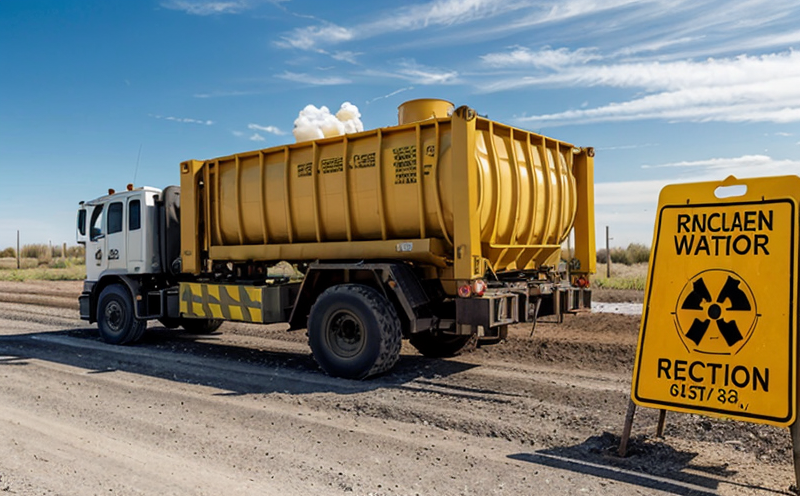ISO 9699 Strontium-90 in Nuclear Wastewater
In the realm of nuclear waste management, the accurate and reliable measurement of radioactive isotopes is paramount to ensuring public safety and environmental protection. The International Organization for Standardization (ISO) has provided a standard method for determining Strontium-90 in nuclear wastewater through ISO 9699:2017. This method ensures consistency across laboratories worldwide, providing accurate results that are crucial for regulatory compliance.
Strontium-90 is one of the most significant radioactive isotopes found in nuclear waste due to its long half-life and ability to accumulate in living tissue. Accurate measurement of this isotope is essential for assessing the safety of nuclear facilities, ensuring proper disposal practices, and protecting workers from radiation exposure.
The testing process outlined by ISO 9699 involves several critical steps: sample collection, pretreatment, chemical separation, counting using a gamma spectrometer, and data analysis. Each step is meticulously designed to ensure precision and reliability, with the final results being reported in units of Becquerels per liter (Bq/L).
Accurate measurement is crucial for several reasons:
- To meet regulatory requirements set by organizations like the International Atomic Energy Agency (IAEA) and national governments.
- To ensure that nuclear facilities are operating within safe limits as defined by international standards.
- To provide data necessary for environmental impact assessments and public safety evaluations.
The standard procedure involves the following steps:
- Sample Collection: The collection of representative samples from wastewater streams is critical. Samples are typically taken at various points in the nuclear facility to ensure a comprehensive understanding of radioactive content throughout the system.
- Pretreatment: This step includes filtering, acidification, and other processes that help to concentrate the Strontium-90 for further analysis.
- Chemical Separation: Using ion exchange resins or precipitation methods, Strontium is separated from the rest of the elements in the wastewater sample.
- Gamma Spectrometry: The purified Strontium sample is then analyzed using a gamma spectrometer to measure its radioactivity. This instrument provides precise counts of the emitted gamma rays, which are directly proportional to the amount of Strontium-90 present.
The results from this testing process provide critical data that informs decision-making processes in nuclear waste management. Regulatory agencies and facility operators use these results to ensure compliance with international standards and to make informed decisions about disposal methods, worker safety protocols, and environmental protection measures.
| Sample Type | Method of Analysis | Units Reported |
|---|---|---|
| Nuclear Wastewater | Gamma Spectrometry | Becquerels per liter (Bq/L) |
Benefits
The implementation of ISO 9699 Strontium-90 testing in nuclear wastewater brings about numerous benefits:
- Enhanced Safety: Accurate measurement ensures that workers and the environment are protected from unnecessary radiation exposure.
- Regulatory Compliance: Ensures adherence to international standards and national regulations, thereby avoiding potential fines and legal issues.
- Environmental Protection: Proper disposal methods can be implemented based on accurate data, minimizing environmental contamination risks.
- Informed Decision Making: Data-driven decisions about facility operations and waste management practices are possible, leading to more efficient processes and reduced costs.
Industry Applications
The application of ISO 9699 Strontium-90 testing is critical in several industries:
| Industry | Specific Application |
|---|---|
| Nuclear Power Generation | Detecting and quantifying Strontium-90 in nuclear wastewater to ensure safe disposal practices. |
| Nuclear Fuel Reprocessing | Monitoring the presence of Strontium-90 during reprocessing cycles to avoid contamination risks. |
| Radioactive Waste Management | Ensuring compliance with international standards for radioactive waste disposal and treatment. |
| Nuclear Research Facilities | Maintaining a safe working environment by monitoring Strontium-90 levels in wastewater streams. |
Environmental and Sustainability Contributions
The accurate measurement of Strontium-90 through ISO 9699 contributes significantly to environmental sustainability:
- Risk Reduction: By ensuring that nuclear waste is managed safely, the risk of radioactive contamination in the environment is minimized.
- Compliance with International Standards: Adherence to ISO standards ensures consistent and reliable testing across different facilities worldwide.
- Data for Environmental Impact Assessments: Accurate data helps in assessing the environmental impact of nuclear activities, leading to more sustainable practices.
The use of this standard method not only benefits individual facilities but also contributes to a broader understanding of nuclear waste management practices globally.





